Paella is essentially a Spanish dish, easy to prepare but complex as a whole. Probably, paella is the most iconic dish of Spanish gastronomy and that’s something you might know, I guess. But there is a lot more about paella, keep reading! 😉
Paella definition, what does Paella Mean?
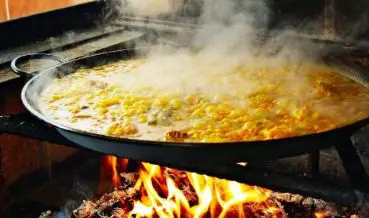
Being purist, the name comes from the Valencian paella, or the Latin patella that means pan. It refers to the wide shallow container where the food is cooked, and the pan gives the name to the Spanish rice-based dish.
However, paella meaning or definition of paella is for us even wider. Paella can be also the act of gathering with family or friends to cook and eat paella (we only eat it for lunch).
So, paella meaning in Spanish can be:
A rounded wide shallow pan
The paella (pan) is a kind of frying pan generally made of iron (the cast iron ones are more appreciated) or steel, wide, with two or more small handles, little depth and large surface.
So, the pan is called simply “paella”, although many Spanish (not from Valencia, of course) usually call it “paellera”.
Learn more about what is paella pan.
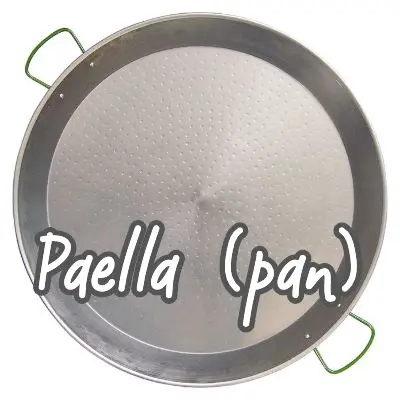
The Spanish typical dish
The paella would have emerged in the 18th century in the area of La Albufera, a lagoon near Valencia. It is believed that in that rice region, a combination of rice with green beans, snails, and eel began to be prepared in a casserole that, over the years, led to the now-traditional paella.
Originally this dish was part of the diet of Valencian peasants, so paella origin has humble roots.
This traditional dish is made with rice and several different ingredients depending on the region and the type of paella. Then, its ingredients will vary from one region to another depending on where it is made. However, there are some ingredients such as rice, olive oil, and saffron that will always be present to make it a real paella.
And the full paella experience comes when you share this special moment with friends, family…
A rice dish made on a paella pan is not necessarily a paella
Paella according to a Valencian, proud of his cuisine and knowledgeable of its history, will try to argue that there is only one paella and that is the traditional one. Made in the Albufera with local ingredients.
In my opinion, respecting this interpretation of the facts, the paella can be and is, any dish whose base has the rice, made in this container the traditional way. Furthermore, containing at least oil, tomato, water, salt, and saffron.
If these requirements are not met, we can call it “arroz de” or “arroz con” (rice with…). Then, the original recipe is Paella Valenciana, and with limited variations, there are several authentic paella types.
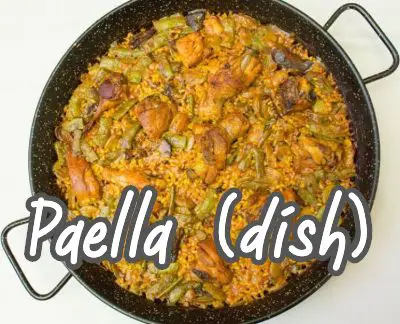
There is a term in the whole Valencian Community that expresses this concept and of general use “anar de paella” (in Valencian) which means “to go for paella” defines the atmosphere that surrounds the process, the experiences of camaraderie and the wonderful process of tasting.
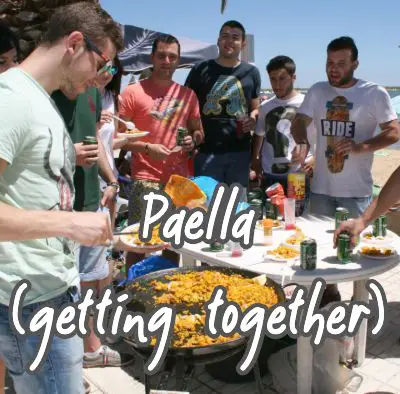
There are those who cannot understand a “Sunday without paella”, it generates myths (and not so myths) about why paella is consumed on certain days of the week, the schisms of the ingredients such as paprika, it is usual the continuous discussions about the dish, but it is undoubtedly the international reference of our cuisine and pride of any Spanish who has an outstanding debt with the farmers of the Albufera.
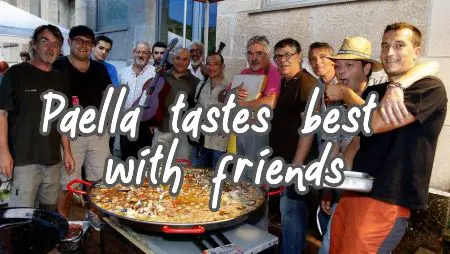
Types of paella
How many types of paella are there? Do you know types of paella and Spanish “rice” you can cook could be endless? Then, basically they can be differentiated by the amount of water added, hence the stock remaining when ready and the type of ingredients.
Based on the water added, paella recipe can be:
- Seco. The rice is dry, light and not sticking together, perfectly “done”
- Meloso. Creamy. There is still a bit of dense stock
- Caldoso. Soupy rice, when rice floats in stock. The pan, then, is a cauldron instead
Considering the main ingredients, they can be:
- Meat (normally with some vegetables)
- Seafood (they can contain some vegetables)
- Vegetarian
- Mixed (vegetables, meat and seafood)
Both basic kinds can be usually combined, for example:
- Meat and dry: Paella Valenciana
- Seafood and dry: Rice aside (A banda) or Black Paella
- Vegetarian and dry: Vegetable paella (De verduras)
- Mixed and dry: Mixed paella (Mixta)
- Meat and creamy: Creamy rice with pork ribs (Arroz meloso con costillas)
- Meat and soupy: Rice with rabbit (Arroz con conejo)
- Seafood and creamy: Seafood paella (Paella de marisco)
- Seafood and soupy: Rice with lobster (Arroz con bogavante)
To end up, we could add another type of dish called Arroz al horno, which could be called baked paella. This is typical of Alicante and it mainly contains pork and vegetables. I can assure it’s delicious. (In my top 5)
Hence, combining ingredients and the stock thing you will never get bored of cooking paella.
Main types of Authentic Spanish Paella

Arroz al Horno Recipe – Baked Rice
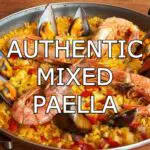
Authentic Mixed Paella Recipe

Fideua recipe (Pasta Paella)

Authentic Spanish Paella Valenciana

Meat Paella
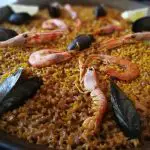
Spanish seafood paella recipe
What Are The Main Ingredients In Paella
If you wonder what are the main ingredients in paella, you landed in the right place. Furthermore, if you’d like to know what ingredients are in paella, the real Spanish paella, you are lucky today.
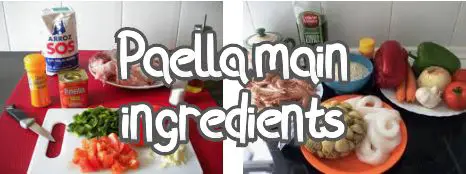
Paella types are endless, but in Spain, we have only a few numbers of pure paella recipes and every type has its own main list of ingredients. However, there is something always repeated:
- Rice
- Olive oil
- Salt
- Water
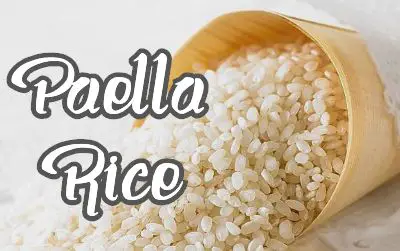
Here you will find them, but you also will find links to delicious paella recipes.
All the following ingredient lists sounds to heavenly music to my ears taste:
Paella Valenciana Main Ingredients
Authentic Paella Valenciana is the most strict one with the ingredient list, as it is ruled by a Denomination Of Origin. So, the mother of paellas is basically based in:
- Bomba rice
- Meat: Chicken and rabbit
- Vegetables: tomato, runner beans, butter beans, artichoke
- Saffron
- Snails
- Extra virgin olive oil
- Salt
- Rosemary

Seafood Paella Main Ingredients
Ingredients of paella seafood can vary, as they are not as strict as Paella Valenciana. Here you have the list of one of the most paella successful paella when it comes to non-Spaniards:
- Paella Rice (learn paella rice types)
- Prawns or shrimps
- Mussels and clamps
- Cuttlefish or squit
- Tomato
- Fresh parsley, onion, garlic, peas
- Extra virgin olive oil
- Salt
- Smoked paprika
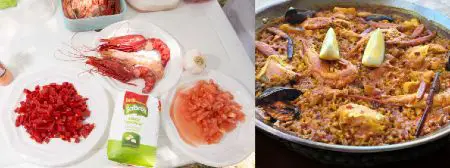
Meat Paella Main Ingredients
This paella ingredients’ list is a bit wider than the previous one, as it admits many variations. However, the main list could be as follows.
- Paella Rice
- Meat: Chicken and/or pork and/or rabbit
- Vegetables: tomato, runner beans, butter beans, red bell pepper
- Extra virgin olive oil
- Salt
- Smoked paprika

Mixed Paella Main Ingredients
The best mixed paella recipe contains the best of seafood and meat paella, altogether. Besides, this paella type is one of the most ordered ones in Spain for tourists.
- Paella rice or bomba rice
- Chicken thigs
- Prawns or shrimps
- Mussels
- Tomato, onion, garlic
- Extra virgin olive oil
- Salt
- Smoked paprika
- Lemon wedges, for garnishing
Chicken Paella Main Ingredients
Chicken paella is easy, so the web is full of easy chicken paella recipes. Maybe that’s why this dish is so popular all over the world. Here you are the main ingredients.
- Paella rice
- Chicken thigs (preferably not breast)
- Garlic, red bell pepper, peas, onion, parsley
- Extra virgin olive oil
- Salt
- Smoked paprika
- Black pepper
- Lemon wedges, for garnishing
Chorizo Paella Main Ingredients
The controversial chorizo paella is mostly made out of Spain, usually accompanied by chicken. I said controversial because although it can be very tasty, it is not well accepted by Spaniards.
- Paella rice
- Chicken thigs (preferably not breast)
- Garlic, red bell pepper, peas, onion, parsley
- Extra virgin olive oil
- Salt
- Spanish chorizo
Vegan Paella Main Ingredients
Vegan Spanish paella admits a wide list of ingredients, being delicious for every diner, either they are carnivorous, vegetarians or vegans.
- Paella rice
- Garlic
- Red bell pepper
- Peas
- Tomato
- Onion
- Parsley
- Saffron
- Butter beans
- Extra virgin olive oil
- Salt
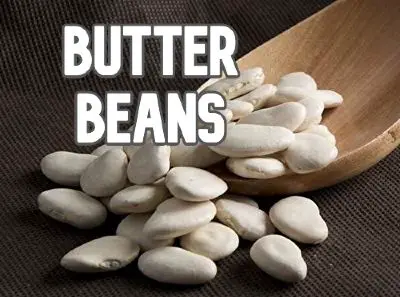
Why is paella yellow?
This color is achieved with a very special ingredient that not only gives it the desired color and typical of the paella, but it also adds aroma and certain flavor. That is very appreciated by those who really know about the tradition of this rich dish, which is not only appreciated in Spain but in other parts of the world.
The star ingredient we are talking about is saffron, an element that is both classic and marvellous. With its bitter taste, aroma and bright colour, it gives a paella dish the appetising appearance that gives it its toasted yellow colour.
In the same process, the lively yellow-orange colour will be distributed through all the ingredients to give the appearance of a real paella.
Why add coloring?
The yellow colour is typical, emblematic and representative in a paella, it is what gives the dish its traditional character.
It should also be mentioned that there are some variations in the preparation where the result is a black rice and there are the white paellas, in which the original colour of the grain is maintained. To choose a quality rice in which the colouring is not necessary, we recommend going to a specialised restaurant, the Barcelona paella of Arrosseria Gaudí is well known in the sector nowadays.
What types of coloring are currently used to color the paella?
The traditional or original recipe uses saffron, which we talked about earlier, however, today this is considered a somewhat expensive ingredient and therefore out of reach of many people who often prepare the paella
To replace it they use the food colouring which requires a greater quantity to achieve the colouring of the recipe, even so it is much more economical to use.
This product is made from corn flour, salt and dye E-102, is available on the market basically in two presentations: pot or envelope.
If you choose the can presentation, it will be enough to add a small spoonful to a preparation for 4 people. If you choose the envelope, you will find the indications that in general the content is fair for a paella of 4 to 6 people.
This type of colouring, unlike saffron, is added to the recipe as soon as the rice is poured, it is sprinkled over the entire surface of the preparation and then stirred with a skimmer to distribute it evenly.
Allow a few minutes to pass, and if necessary add a little more until the desired colour is achieved.
Saffron or food colouring?
For cooks who are experienced in preparing paella and who stick to tradition, the bet is on saffron, but its price compared to food coloring is much higher.
Saffron requires less quantity to achieve the characteristic yellow of the recipe, and it also adds a special aroma and flavour. The food colouring requires more quantity to achieve its purpose, but it must be said that it does not add any additional flavour to the rice grains.
Recommendations before buying saffron
- Make sure they are pure saffron stamens, because you can find petals and roots of this ingredient in the shops, which do not provide the same taste.
- One way to check that the ingredient is fresh is to put a couple of strands in boiling water, these should be softened and soon after they are gone. If it takes too long to fade, it is because it is not fresh or because it is not yarn.
- To optimize the effect of the saffron, put some strands toast, which you will put in aluminum foil, pass this through the fire briefly and on both sides, finally use it. Select a good brand of the product to know what they are, there are guides and recommendations on the internet.
There are times when saffron does not produce the expected yellow-orange color, there are several explanations for that:
- That it’s not a quality product.
- That it is not fresh.
- That you are not applying it in the right way.
- Paellas that have the yellow color
- Two examples of paellas with yellow rice grains are the Valencian paella and the mixed paella, both of which use saffron as the food colouring.
In the case of the Valencian paella, there is nothing like the intense and natural yellow colour achieved by using saffron, as well as the aroma and flavour of the ingredient when used in the right way.
Unfortunately, the preparations of this recipe using saffron are mostly limited to very special occasions or in places where they specialize in the preparation of this, in the traditional way and where the price of a dish is sure to be higher.
How to distinguish authentic Paella?
You may have wondered if the color of the rice can tell you if the paella in front of you is quality or not.
World-famous, paella is the dish that any tourist who comes to our country wants to try. Therefore, it is not surprising that it is present in the menu of most restaurants of Mediterranean and Spanish cuisine, as well as in beach bars. However, finding a good paella is no easy task.
Unfortunately, the paellas offered in many places seem artificial and adulterated. They don’t look like it, they are. They are industrial paellas, cooked with irregular heat and with a worrying canary yellow or artificial reddish colour reminiscent of “Caution” signs.
And that is precisely what you should be careful about: caution with the paellas that are cooked and served in some restaurants. You know, paella is either eaten at home or in specialized places. But we have become accustomed to it and it is common to see it everywhere. We do not discover anything new if we tell you that many come frozen in a bag, and ready to just add a little water. A pitiful kitchen, yes.
When you go to eat paella in Spain, be guided by your sight and your common sense.
Proper paella check list
- Keep away from touristic places, as paella served for tourists are generally a waste of money.
- Check out the paella rice type. If you see long rice grains… run away!
- The second thing you should look at is the color. If the grains are a bright yellow, almost phosphorous, what you are seeing is a 100% artificial paella of very low quality. A quality paella is orange-yellow in colour, due to the saffron and sweet paprika powder (the only two spices used for the paella). saffron gives a unique flavour and aroma and colours the rice a colour that has nothing to do with the reddish-orange of paellas made with artificial colourings and which are supposed to attract more people.
- Let them serve it to you at the table, directly from the paella (the pan in which it is made, and that is also its name). You should see what a thin layer of rice looks like and that it has its corresponding “socarrat” (that darker layer that is the rice stuck to the bottom of the container). Run away from the paellas that you see doughy and very thick.
When is paella eaten?
For many Spanish families in Valencia and even in many other parts of Spain, paella is on the menu once a week, normally on weekends. But the paella day is definitely Sunday.
Where Spaniards eat paella?
Many of the families live in the busy city during the working week and have a rural house or a small house in the countryside.
On weekends many people from the city go to this houses to escape from the noise and enjoy the nature. Of course, there is always a paella lunch.
Sunday is paella day
When the paella is on the menu, the whole family gathers on Sunday mid-morning. While the cook (or cook and helper) make the paella, the dinners are patiently around, waiting with snacks, small tapas and drinks.
But at three o’clock in the afternoon, a large Paella arrive to the big dining table. The cook, full of proud shows its creation hoping to delight them.
Then, the family/friends gathers around the paella pan and enjoy the paella while commenting how good it is, the cooking point of the rice, if it is salty enough…
So, answering a repeated question: We eat paella for lunch. Only for lunch.
Lunch is the principal meal in Spain, and paella is a typical lunchtime dish. Most restaurants only serve it during lunch. However, if you are on holiday in Spain, you can eat paella almost every day and either for lunch or dinner.
If you fancy eating paella in a restaurant in Spain, you should get to the restaurant later than 3 pm. The restaurant kitchens close around 16.00 hrs.Are you going away for a paella? My recommendation is to book in advance. Particularly in the real rice restaurants, which may be crowded.
When reserving, you can also specify the paella type you would like to eat, which saves you time once you arrive at the restaurant.
To know more about paella, you can check out:
PAELLA FAQ
How many different types of paella are in Spain?
Paella types are almost countless, because ingredients can vary. However, there are very few basic paella types:
– Paella Valenciana
– Meat Paella
– Seafood Paella
– Mixed Paella
– Vegan Paella
Learn more about paella types > here <
How to make traditional paella?
There are many traditional paella types, Valenciana, Mixed, Seafood… and every one has its own features.However, to make a traditional paella my recommendations is:
– Use the right rice type
– Prepare a proper stock
– Sauté the ingredients
– Follow a traditional paella rice cooking method
Is paella traditionally served at weddings?
No, it is not. Definitely not. At least not in Spain. Learn more about paella dont’s here
When is paella traditionally eaten?
Spanish people eat paella for lunch and rarely for dinner. We love to gather with friends and family on weekends to eat paella for lunch. Learn more about paella here <
What does paella taste like?
Paella does not have a flavor per se, it’s not like. Paella taste might be very different depending on the rest of the ingredients, and the way it is made. Learn more about paella taste here <
